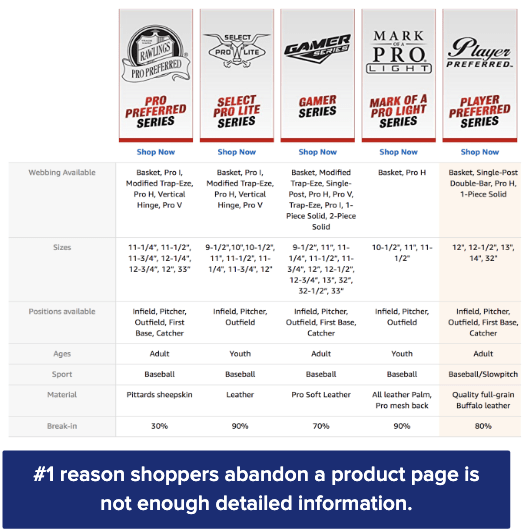What Is Enhanced Content and How Can It Boost Conversions?
Written By: Betsy Timbers
It’s never been more important to stand out on the digital shelf.
Enhanced content empowers you to captivate your audience, whether you’re trying to reach a consumer or a business. Brands that sell to retailer and distributor customers can also benefit from providing this type of content to their partners.
Brands can lift sales, on average, 15 to 58% on Amazon.com by improving product content to meet bestseller benchmarks in their category, according to a Profitero report. The biggest lifts come from adding videos, followed by adding more images, and finally from improving enhanced content.
What Is Enhanced Content?
Enhanced content transforms regular product detail pages (PDPs) into brand experiences — providing engaging product content and rich media (A+ content) that may include videos, images, comparison charts, and more.
Today’s shoppers have many choices; enhanced content helps inform their decisions and cultivate trust.
Enhanced Brand Content Requirements
Right now, brands and manufacturers have three huge, scalable opportunities to use enhanced content on their digital catalogs and product pages: video, A+ content, and comparison charts.
When comparing similar products online, 18% of U.S. consumers would choose the higher-priced option if it had better product images or videos, according to Salsify’s 2022 consumer research report, “How to Meet the Demands of Omnichannel Shoppers.”
The report also found that personally relevant images, videos, text, and reviews on product pages make U.S. consumers nearly 70% more likely to make a purchase.
Enhanced content helps you provide the expected level of detail for anyone browsing or shopping your products in any context.
You can use brand videos, other forms of rich media like audio, and comparison charts in innovative ways to encourage consumers to engage with your brand — ultimately driving conversions.
As highlighted in Forbes, the benefits of using enhanced brand content on Amazon, for example, include an increase in sales by an average of 3 to 10%.
Objectives of Enhanced Content
Enhanced content allows you to promote your brand and differentiate it from the competition.
Below-the-fold video and high-resolution product images give a deeper dive into what makes your brand unique. They also ensure consistent storytelling opportunities across all of your touch points, empowering you to best showcase your key features.
Comparison charts serve as another important element to further elaborate on your product line and answer questions customers frequently ask.
Enhanced Content Best Practices
Think of enhanced content as an ever-present, always current, universally accessed sales pitch deck. Enhanced content equips your salesforce with the tools they need to sell better.
Tailor to Your Teams
By using dynamic elements (like video and image galleries) in your digital sell sheets and product catalogs, you can develop product pages that become an easy-to-access salesforce enablement tool for your teams.
Tailor to Your Clients
There are different types of layouts, and with product-specific rich media, clients will feel as though the experience has been tailored to their needs — because it has been, just with less fuss and more efficiency on your end.
Why Enhanced Content Works
Enhanced content makes it easier than ever for customers to compare the features that matter most to them when making a purchase.

Your business buyers are also everyday consumers who shop for home décor, consumer packaged goods (CPGs), and clothing just like everyone else. Why wouldn’t they expect the same experience when shopping while on the clock?
With enhanced content, easy-to-build comparison charts pull from your latest product insights. Right away, clients have access to the competitive research they need all in one place, saving them time and energy.
What To Expect With Salsify Enhanced Content
One example of Salsify Enhanced Content in action involves a home furniture brand customer. They were able to develop and publish 800 enhanced content pages in just two days, saving them nearly $80,000.
This was made possible by Salsify’s unified platform, in which product data and enhanced content capabilities live in the same system.
Now, brands can map product attributes to templates and create enhanced content pages for multiple products at once — instead of going through the time-consuming, expensive process of building layouts one at a time.
Watch our on-demand webinar, “Increase Sales Rank and Product Page Conversions with Enhanced Content,” to learn how to devise a winning enhanced content strategy.
Written by: Betsy Timbers
Betsy Timbers is a Sr. Product Marketing Manager covering Salsify's Connections and Ecosystem solutions.
Recent Posts
5 Ecommerce Tips To Help Marketers Enter the New Year Stress-Free
How Many Digital Sales Channels Do Shoppers Review Before Purchasing Products?
What the Data Says About Consumer Interest in AI Shopping Agents
Subscribe to the Below the Fold Newsletter
Standing out on the digital shelf starts with access to the latest industry content. Subscribe to Below the Fold, our monthly content newsletter, and join other commerce leaders.


.svg)